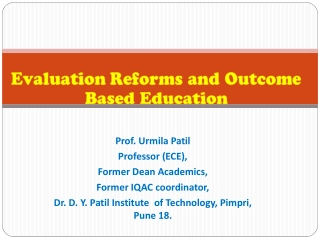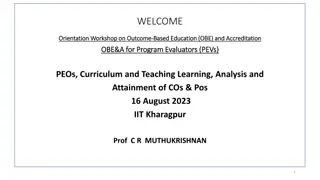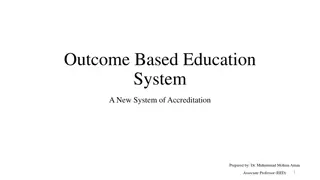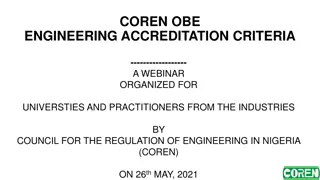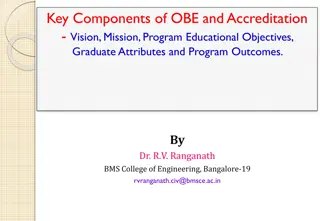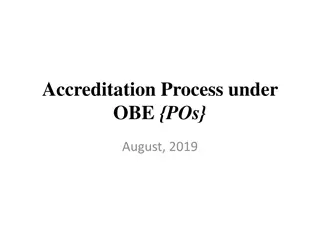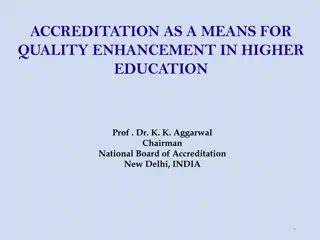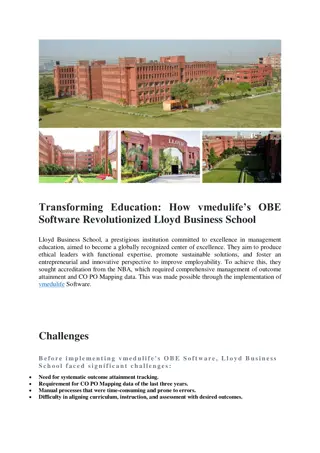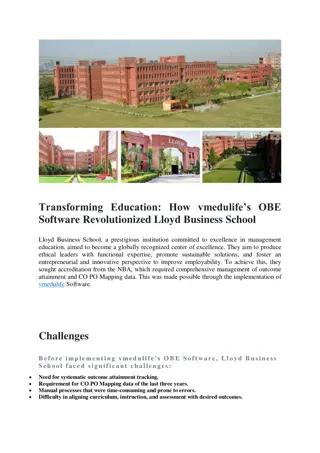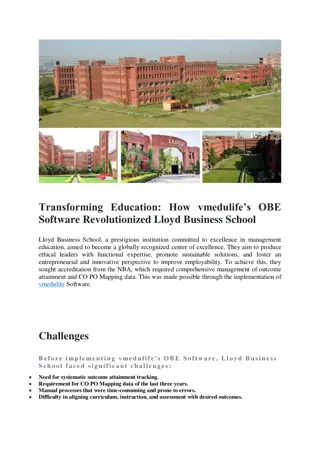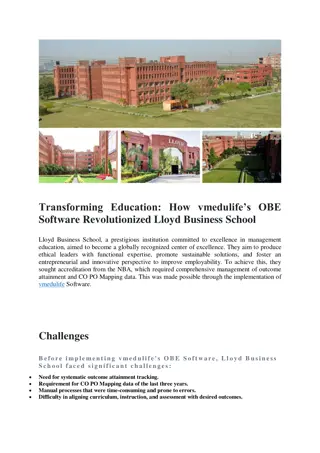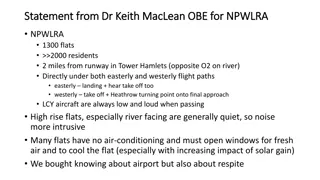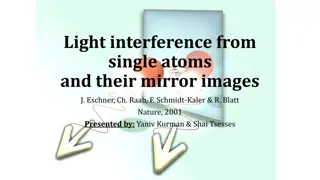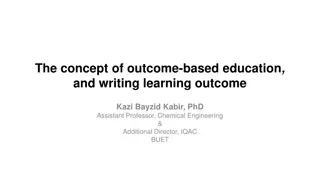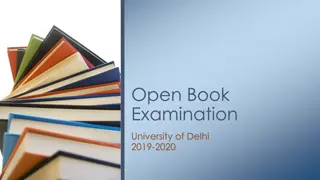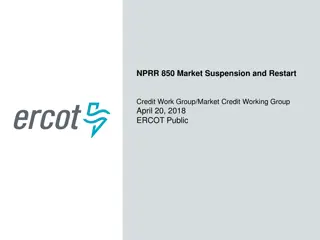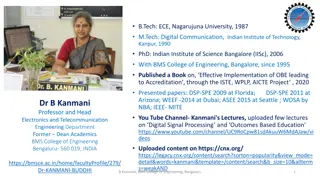
EM Wave Characteristics and Transmission Lines in Electromagnetic Theory
Explore the intricacies of Electro Magnetic Theory and Transmission Lines with a detailed syllabus covering topics such as Electrostatics, Magnetostatics, Maxwell's Equations, EM Wave Characteristics, and Transmission Lines. Dive into concepts like Electric Field Intensity, Gauss Law, Biot-Savart's Law, Maxwell's Equations, Wave Propagation, Reflection, Refraction, and more. Enhance your understanding of EM waves and transmission line parameters for a comprehensive grasp of this core subject in engineering.
Download Presentation

Please find below an Image/Link to download the presentation.
The content on the website is provided AS IS for your information and personal use only. It may not be sold, licensed, or shared on other websites without obtaining consent from the author. If you encounter any issues during the download, it is possible that the publisher has removed the file from their server.
You are allowed to download the files provided on this website for personal or commercial use, subject to the condition that they are used lawfully. All files are the property of their respective owners.
The content on the website is provided AS IS for your information and personal use only. It may not be sold, licensed, or shared on other websites without obtaining consent from the author.
E N D
Presentation Transcript
Outcome Based Education IT S NOT WHAT WE TEACH, IT S WHAT THEY LEARN by Dr P H Waghodekar, Aurangabad
COURSE INFORMATION SHEET Course Name: Electro Magnetic Theory and Transmission Lines Course Number: A54022 Course Designation: Core Credits: 4 Prerequisite: PHYSICS, Vector Calculus, PDE s Year and Semester: II B.tech II Semester
SYLLABUS UNIT I: ELECTROSTATICS: Coulomb s Law , Electric Field Intensity- Fields Due to Continuous Charge Distributions, Electric Flux Density, Gauss Law and Applications , Electric Potential, Relations Between E and V , Maxwell s Two Equations for Electrostatic Fields, Energy Density , Illustrative Problems. Convection and Conduction Currents, Dielectric Constant, Isotropic and Homogeneous Dielectrics , Continuity Equation, Relaxation Time, Poisson s and Laplace s Equations, Capacitance Parallel Plate, Coaxial, Spherical Capacitors, Illustrative Problems. UNIT II: MAGNETOSTATICS: Biot-Savart sLaw , Ampere s Circuital Law and Applications, Magnetic Flux Density, Maxwell s Two Equations for Magnetostatic Fields, Magnetic Scalar and Vector Potentials, Forces Due to Magnetic Fields, Ampere s Force Law, Inductances and Magnetic Energy, Illustrative Problems. UNIT III: MAXWELL S EQUATIONS (Time Varying Fields) : Faraday s Law and Transformer emf, Inconsistency of Ampere s Law and Displacement Current Density, Maxwell s Equations in Different Final Forms and Word Statements, Conditions at a Boundary Surface: Dielectric-Dielectric and Dielectric-Conductor Interfaces, Illustrative Problems.
SYLLABUS UNIT-IV: EM WAVE CHARACTERISTICS: Wave Equations for Conducting and Perfect Dielectric Media, Uniform Plane Waves- Definition, All Relations Between E & H, Sinusoidal Variations, Wave Propagation in Lossless and Conducting Media, Conductors and Dielectrics- Characterization, Wave Propagation in Good Dielectrics and Good Conductors , Polarization, Reflection and Refraction of Plane Waves Normal and Oblique Incidences, for both Perfect Conductor and Perfect Dielectrics, Brewster Angle, Critical Angle and Total Internal Reflection, Surface Impedance, Poynting Vector and Poynting Theorem-Applications, Power Loss in a Plane Conductor, Illustrative Problems. UNIT-V: TRANSMISSION LINES: Transmission Lines I: Types, Parameters, Transmission Line Equations, Primary & Secondary Constants, Expressions for Characteristic Impedance, Propagation Constant, Phase and Group Velocities, Infinite Line Concepts, Losslessness/Low Loss Characterization, Distortion Condition for Distortionlessness and Minimum Attenuation, Loading - Types of Loading, Illustrative Problems. Transmission Lines II : Input Impedance Relations, SC and OC Lines, Reflection Coefficient, VSWR, UHF Lines as Circuit Elements: /4 , /2, /8 Lines Impedance Transformations, Significance of Zmin and Zmax Smith Chart Configuration and Applications, Single and Double Stub Matching, Illustrative Problems.
TEXT BOOKS, REFERENCE BOOK, WEB/OTHER RESOURCES TEXT BOOKS: 1. Elements of Electromagnetic Matthew N.O. Sadiku, Oxford Univ. Press, 4th ed., 2001. 2. Electromagnetic Waves and Radiating Systems E.C. Jordan and K.G. Balmain, PHI, 2nd Edition, 2000. 3. Transmission Lines and Networks Umesh Sinha, Satya Prakashan (Tech.India Publications), New Delhi, 2001. REFERENCES: 1. Engineering Electromagnetic Nathan Ida, Springer (India) Pvt. Ltd., New Delhi, 2nd ed., 2005. 2. Networks, Lines and Fields John D. Ryder, PHI, 2nd ed.,1999. 3. Engineering Electromagnetics William H. Hayt Jr. and John A. Buck, TMH, 7th ed., 2006. 4. Electromagnetic
Outcomes in OBE Vision and Mission of the Institution/Faculty Complement Each Other Interrelated and Long-term Outcomes Programme Educational Objectives (PEO) Programme Outcomes (PO) Short-term Outcomes Learning Outcomes (CO) of Subjects By Dr P H Waghodekar, Aurangabad 6
COURSE OBJECTIVES 1. To provide the basic concepts of Electric and Magnetic fields. 2. To understand the Maxwell s equations and applying boundary conditions to the different material interfaces. 3. To conceptualize the wave propagation characteristics for different media. 4. To learn the basic parameters of Transmission lines.
COURSE OUTCOMES : After going through this course the student will be able to 1 Apply the basic concepts of Electric and Magnetic fields in static and time varying conditions. 2 Apply Maxwell s equations to solve equations of EM fields. 3 Apply wave propagation characteristics and power calculations in applications like antennas. 4 Design a loss/distortion less transmission system.
CO ASSESMENT State Coulombs Law and Write the equation for F [L1, CO1] Explain the concept of Mutual inductance [L2, CO2] Determine the equation of electric field intensity due to infinite line charge [L3, CO1] A conducting bar can the slide freely over two conducting rails then calculate induced voltage in the bar [L4, CO3] Compare Maxwell's equations of Time varying fields with Time in-varying fields [L5, CO3] Design or Propose a single stub which can be used to combine two transmission lines with the wave length of /4. [L6, CO4]


